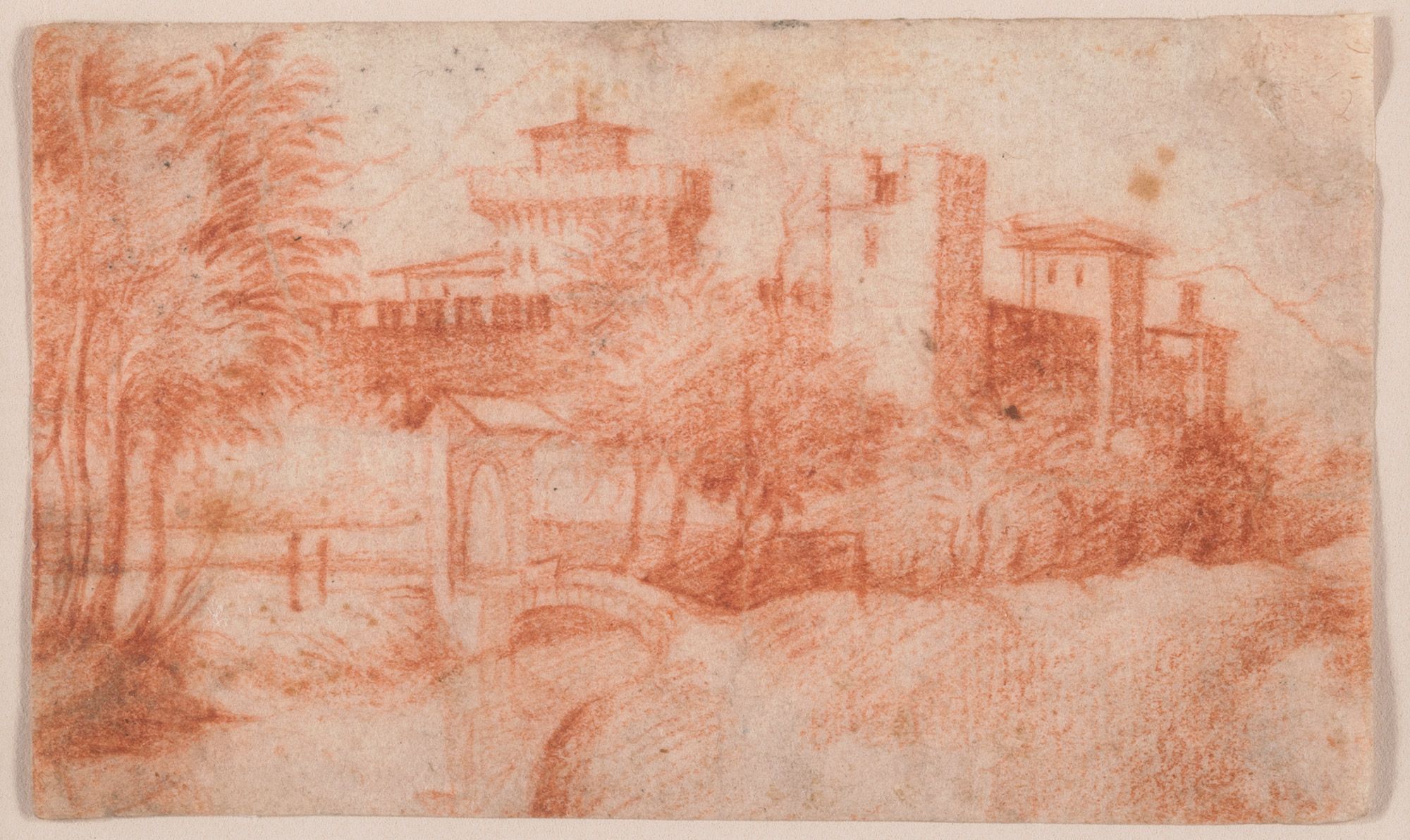FJK 054
Giorgione (Giorgio Barbarelli dit) (Italian, Castelfranco Veneto 1477/78–1510 Venice)
Landscape with a Town Surrounded by Ramparts
vers 1500-1504
2 31/64 × 4 9/64 in. (63 × 105 mm)
Medium
Red chalk on paper
Numbered in brown ink on the back: 665
Stamp from an anonymous collection: a rat inscribed in an oval
Origin
André de Hévesy Collection, Paris
Pascal Ruys Raquez Collection, Brussels
Sale, Christie’s, London, July 5, 2005, no. 24
Jan Krugier Collection, Monaco, JK 6561
Jan Krugier Foundation
Bibliography
TIETZE Hans, TIETZE-CONRAT E., The Drawings of the Venetian Painters in the 15th and 16th Centuries, New York, 1944; reprint, New York: J. J. Augustin Publisher, 1970,, p. 175, no. A716, pl. XLVIII, 2.
PIGNATTI Terisio, Giorgione. Complete Edition, London: Phaidon publishers Inc., 1971, “Related Works”, p. 153, no. V28, (under circle of Giovanni Bellini).
REARICK William R.,Il disegno veneziano del Cinquecento, Milan: Electa, 2001, pp. 20-21, fig. 6, (under Giorgione).
REARICK William R., “Studi Tizianeschi,” in Annuario della Fondazione Centro Studi Tiziano e Cadore, II, Silvane Editoriale, 2004, p. 73-74, fig. 38 (under Giorgione).
Exhibitions
Brussels, Société Générale des Banques, Dessins du xvie au xviiie siècle dans les collections privées de Belgique (Prof. R.-A d’Hulst, G. Grieten, P. Ruys-Raquez, A. van Egeren), 1983, p. 122, no. 53, ill. p. 123 (under circle of Giorgione).
Ixelles, Musée Communal d’Ixelles, De Giorgione à Tiepolo. Dessins Italiens du du xve au xviiie siècle dans les collections privées et publiques de Belgique, cat. by B. Boëlens van Waesberghe, G. Grieten, P. Ruys-Raquez, Roland Soenen, October 8 – December 12, 1993, pp. 31-32, no. 4, ill. p. 30 (under Giorgione).
Rotterdam, Kunsthal, European Master Drawings Unveiled: Van der Goes, Michelangelo, Van Goyen, Fragonard and other masters from Belgian Collections, cat. by B. Boëlens van Waesberghe, C. Kruyfhooft, J.L. Pypaert, P. Ruys-Raquez, R. Soenen, 2002, p. 167, no. 71, color ill. p. 166 (under Giorgione).
Munich, Kunsthalle der Hypo-Kulturstiftung, Das Ewige Auge - Von Rembrandt bis Picasso. Meisterwerke aus der Sammlung Jan Krugier und Marie-Anne Krugier-Poniatowski, 2007, p. 42, no. 13, color ill. p. 43.
Notes
Among all the drawings by Giorgione, the present sheet is the closest one from the drawing in red chalk at the Museum Boijmans Van Beuningen in Rotterdam, representing a young shepherd in a landscape, likely the site of Castelfranco (Tietze, no. 709).
This drawing is the only one unanimously attributed to Giorgione. Tietze thinks it gives an exact idea of the original state of the drawing in red chalk in Rotterdam, before his owner Padre Resta “washed it the best he could” (Tietze, no. 716).
Pignatti attributes the drawing to the circle of Giovanni Bellini. No sketch in red chalk is known by this master, which does not exclude the possibility that he was not tempted by this medium.
We know that Bellini’s style evolved considerably towards the end of his career, as shown by his last paintings, for instance Virgin with Saints at the Church of San Zaccaria in Venice, The Drunkenness of Noah in the Museum of Fine Arts in Besançon, and The Three Ages of Humans in the Pitti Palace in Florence.
This landscape reappears twice: first in a painting representing Saint Sebastian, a poor work by a follower of Bellini (B. Berenson, Italian Pictures of the Renaissance, Venetian School, vol. I, pl. 249; vol. II, pl. 630), and in Virgin with Child by Previtali, which by comparison with a similar painting dated 1504, seems to be contemporary or no later than 1504-06 (I. Kunze, “A Rediscovered Picture by Andrea Cordeliaghi,” The Burlington Magazine, December 1937, vol. 71, no. 417, p. 261, pl. II A).
The site is likely depicted from nature. It is perhaps the profile of another small town in Veneto, surrounded by ramparts like Castelfranco. This type of landscape appears in many Venetian paintings of the time (Exh. Cat. Brussels, 1983, p. 122).
Request for information/loan
The Jan Krugier Foundation is devoted to increasing the impact of the collection of drawings through regular loans to major exhibitions. Loan applications should include a complete presentation of the project.

